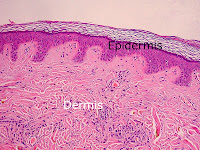Home > Structure of dermis layer
Adipocytes (fat cells), fibroblasts, leucocytes and nerve cells are the major types of tissue components found in this region. Depending upon its location on the body, the thickness varies. It is thinnest on the eye lids and thickest on the back. The structure of dermis can also be divided as per its functional tissue components.
Connective tissue
Dense irregular connective tissue, comprising rows of fibroblasts (fiber forming cells) crowded between collagen and elastin fibers, is arranged in sheets in lower region and the upper region is made up of loose connective tissue.
Fat deposits
Fat deposits are found in this region. The thickness of the fat deposits vary in genders and men and women have different areas of fat concentration. Numerous adipocytes (fat cells) are present in groups known as fat lobules.
Vascular tissue
There is a network of blood vessels mainly comprising arterioles, venules and capillaries in this layer.
Extensive network of lymphtic vessels are present in dermis supplyin protective immune cells.
Appendages
Hair follicles are present in this region and are present throughout the body except lips, palms and soles.
Glands
Eccrine glands (sweat glands) are present in the dermis and are dispersed throughout skin regions. Apocrine glands (scent glands) are present in axilla and anogenital regions of dermis. Sebaceous glands (sebum or oil glands) are found in dermis.
Muscles
Smooth muscle structure like Arrector pili muscle is found attached to the base of hair follicle.
Sense organs
There is sensory as well as autonomic nerve network dispersed throughout dermis making skin sensitive to touch and other stimuli. Meissner's corpuscles (touch receptors), Pacinian corpuscles(pressure and vibration receptors), free nerve endings (itch, pain and temperature receptors) and nerve fibers are present.
Immune system
Leukocytes (white blood cells) like neutrophils, monocytes, macrophages, mast cells and T-lymphocytes are present here.
Interesting topics in dynamic skin care:
- Know the structure and function of your skin.
- Nourishing skin with fruits and vegetables.
- Small itchy water blisters on hands and feet.
- Cosmetic procedures with lasers.
- Nevus simplex - Salmon patches.
- What is hemangioma?
- Hemangioma removal.
- Carotene in carrots.
- Types of urticaria.
- Chronic urticaria.

No comments:
Post a Comment